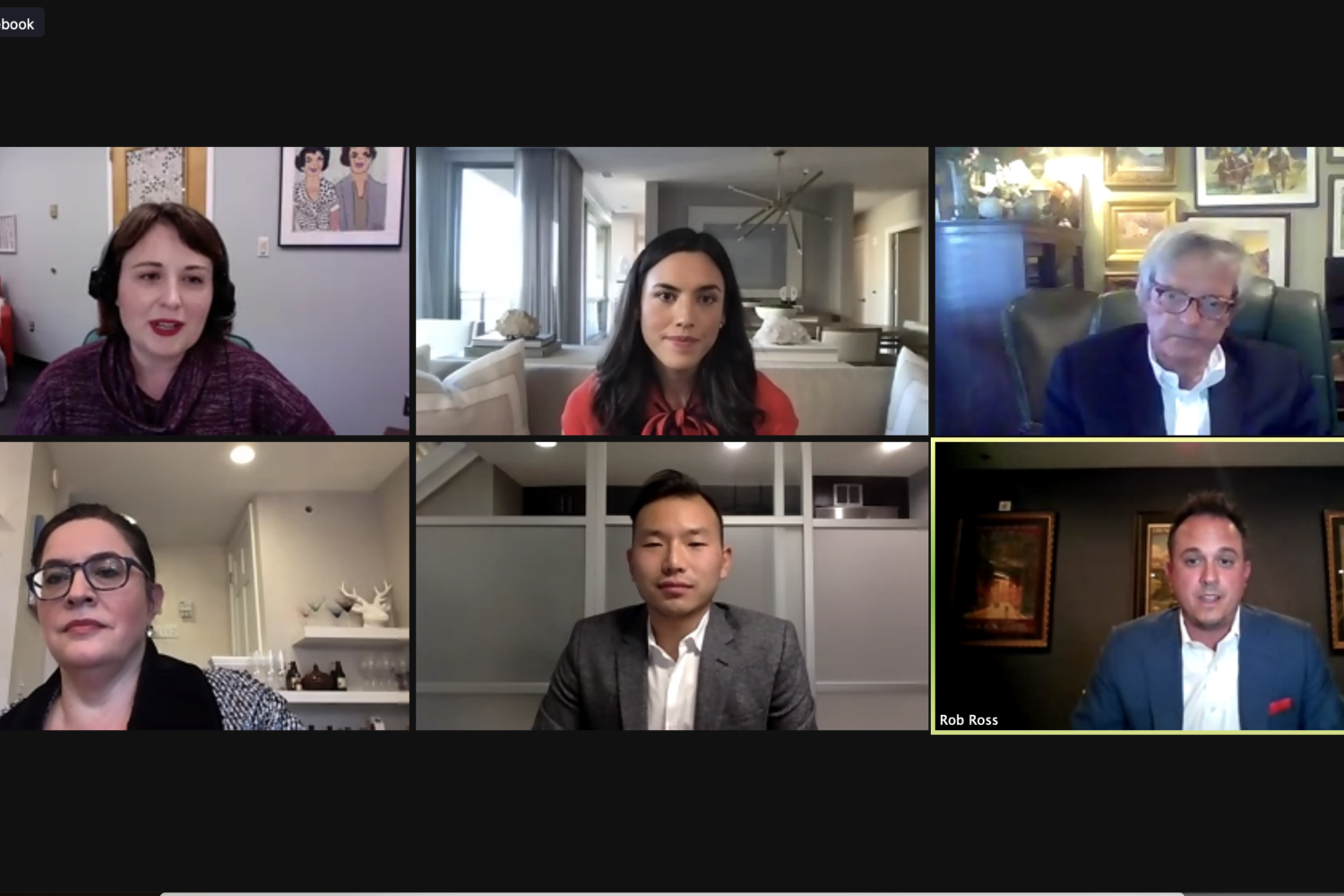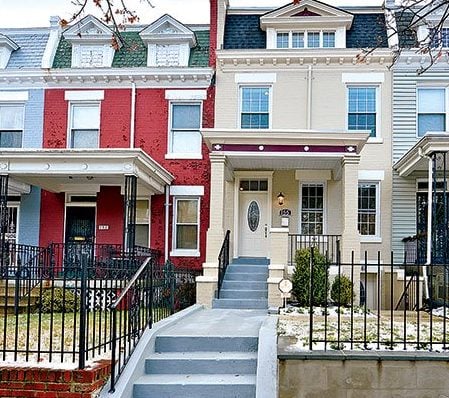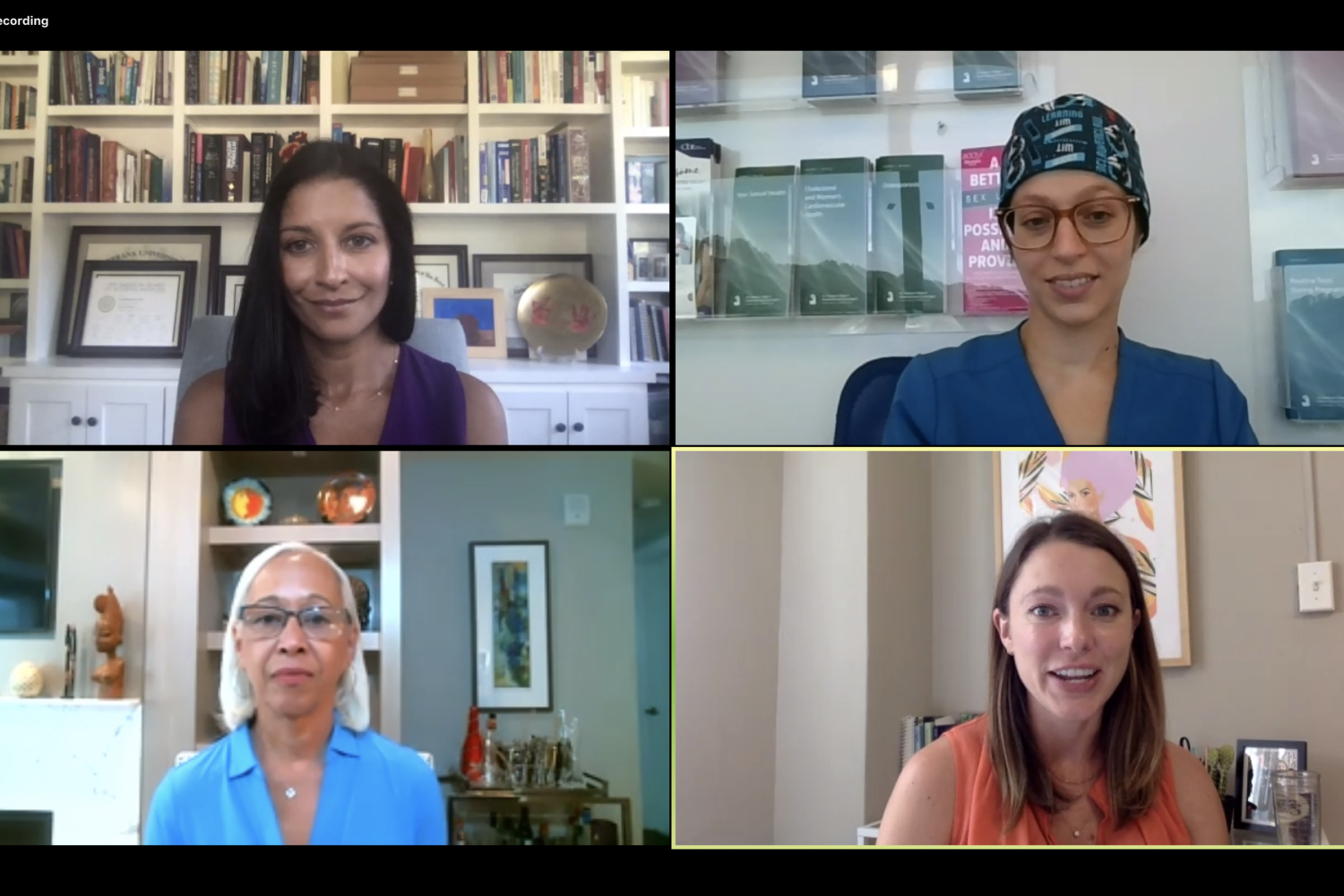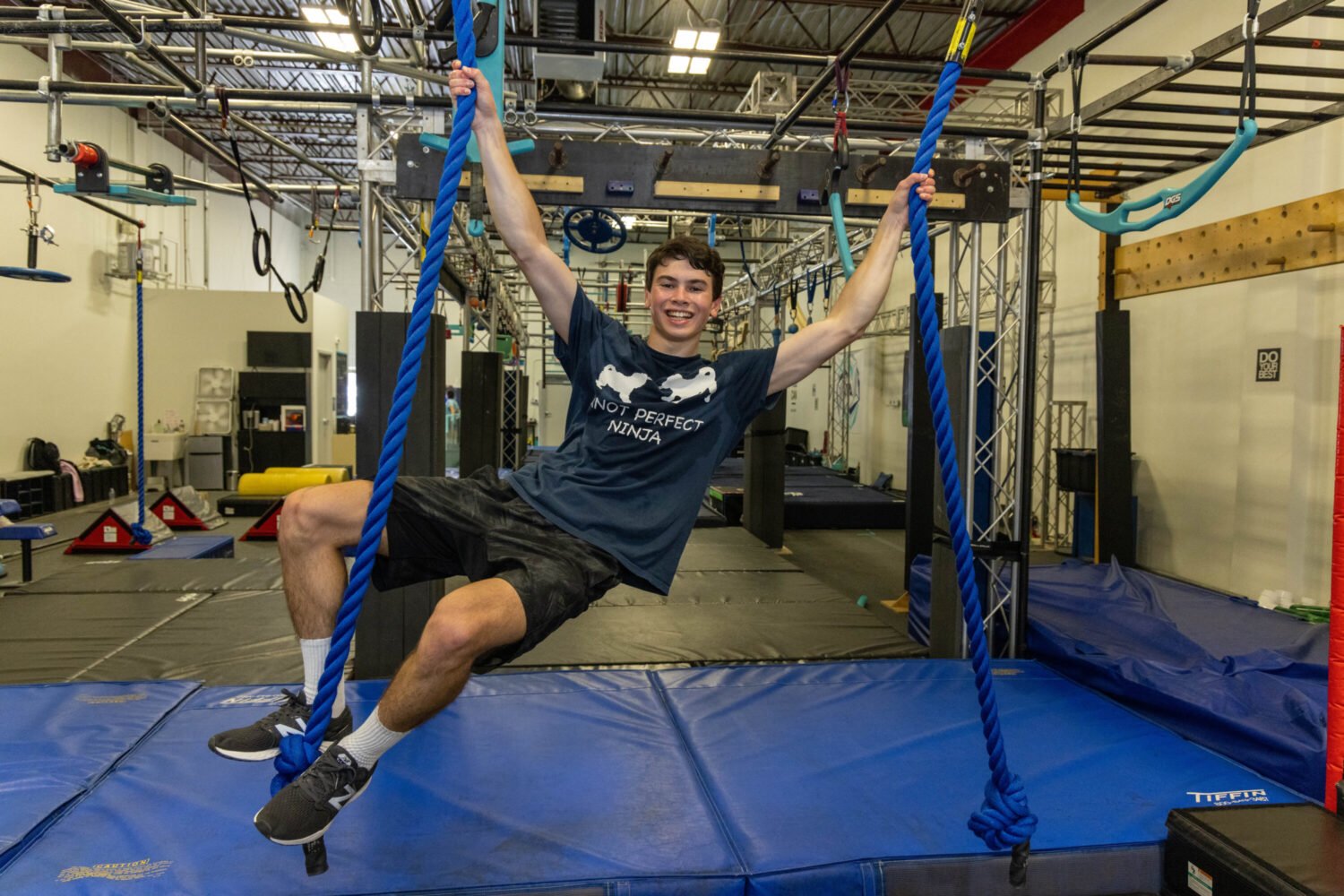In the multipurpose room of DC's Bell Multicultural High School, a dozen kids slouch in chairs, looking ill at ease in their white shirts and dresses. At the front of the room, two teachers place crystal candleholders on a cloth-covered table. In the back, a few parents come in and settle at long rectangular tables.
One of the students, 16-year-old José Rosales, fidgets with his geometric-patterned tie, a recent gift from his mother. He cranes his neck to look around the room, checking to see who has come in. Then he turns to the front, where a petite, dark-haired girl walks to the microphone and welcomes those seated.
"In 1921, Dr. Edward Rynearson founded the first chapter of the National Honor Society. You are here because you exemplify our four pillars: scholarship, service, leadership, and character," says Hong Nguc Nguyen, a recent Bell graduate.
A different student stands up to describe each trait, lighting a candle before speaking. Then the inductees are instructed to stand and raise their right hands.
José's posture is perfect when he holds his hand up. "I pledge myself," he says in unison with the other students, " to uphold the high purposes of the National Honor Society to which I have been selected."
A few minutes later, Hong returns to the microphone to call each new member's name. "José Rosales," she says.
His pursed lips give way to a beaming smile as he walks up to the podium. José shakes hands with the principal, who hands him his certificate and attaches a small gold pin to his lapel. As this year's valedictorian, José knows he deserves this.
As he returns to his seat, there is a moment where he slows to face the small audience. It's as if he wants them to get a good look at him. Maybe because he knows what they don't: All the honors, grades, clubs, community involvement, and shots at a bright future mean nothing if you don't have legal residency.
José is a Salvadoran immigrant who was carried above the currents of the Rio Grande River by a paid smuggler when he was ten years old. He still has a chance of being deported. And it's happening just as his dreams of being the first in his family to attend college are coming to fruition.
He sits down in his seat and watches the other students accept their awards. After the last name is called, sandwich trays are brought out. Kids smile, parents hug, teachers congratulate. José looks on.
"These are the times I feel sad," he says, "because my mom isn't able to come. And it's frustrating because I work so hard."
A few blocks away, on the third floor of a brown-brick apartment building overlooking Mount Pleasant Street, is the apartment where José and his family have lived the past three years. It has two rooms, with a floral shower curtain to change the living room into a bedroom. Duct tape on the drafty windows tries to keep the cold out.
One room houses his aunt and her two-year-old daughter, Isis. In the other, José and his mother sleep in bunk beds, his stepfather on the floor. At the center of the room is a beat-up office desk with two books, a calculus text and Richard II, on top.
When José puts his backpack down on his desk, Isis runs in and out of the room screaming. Pots clang in the tiny kitchen. Next door, a TV blares out a talk show. Outside an ambulance and police cars speed by.
"It's why I'm never home," says José, who knows his mother is worrying about paying the rent while he goes somewhere to study for his Advanced Placement calculus exam. "I just can't concentrate here."
José and his mother emigrated to the United States in 1994 to escape family troubles, leaving behind a poor homeland recovering from years of civil war.
But if life in El Salvador was a struggle, their life here proved even more tumultuous. After José and his mother arrived in DC, José's stepfather, Conrado, was hit by a taxi and has been unable to work. His mother, Maribel, quickly learned that "making it" meant scraping by to pay bills each month, spending less and less time with her son.
Maribel did what she had to, spending the past six years cleaning hotels and office buildings–sometimes working 12 hours a day for $6 or $7 an hour.
"After work sometimes I can barely talk or walk . . . I can't do nothing. I'm so tired," she says. But after taking the bus home and opening the door to the apartment, "I would see my son and I'd be okay. José is my inspiration."
She and her son are not legal US residents–something that they could get around until recently. But now José is applying to college, and without a Social Security number, he can't qualify for financial aid. Instead, he is applying as an international student in the hope that he'll be awarded a full scholarship to cover tuition, room, and board.
Even though they have lived here for six years, and José has risen to the top of his class in school, crossing the threshold into mainstream America is difficult.
Before President Bush took office, then-President Bill Clinton was expected to sign a bill giving more than a million Central American immigrants refugee status. But the bill was watered down, and in December a revised bill was signed. This one leaves little hope for Central American immigrants hoping to legalize their status.
In March, José and other Salvadoran illegals were given reprieve when heavy earthquakes destroyed buildings and homes and injured thousands in El Salvador. Consequently, President Bush signed a waiver allowing illegal Salvadoran immigrants to stay in the United States for 18 months so they could work to send money home to their families. José can breathe a sigh of relief–for now. But the waiver won't help him become a legal resident.
"If I'm the valedictorian and have to go up on that stage and talk about moving on and going to college, what am I going to say?" he asks. "If I don't go to college, it won't be because I don't want to or because I can't. It'll be because I'm missing something others kids are born with–my papers."
José has reasons to be hopeful. His stepfather became a citizen last year, which may help José get legal "green card" status. He also is receiving help from local philanthropist Richard England. José won a $2,500 scholarship from England, which he is using for his legal fees, and England has offered to pay the rest of his $6,000 legal bill.
Still, José's mother cannot hide her bitterness. "I hate the phrase that people use, el sueño Americano, the American dream," says Maribel. "To hear it makes me cringe. For us, it has been the American nightmare."
For all his immigration troubles, José Rosales is closer to grasping the elusive "American dream" than many other young Latino immigrants.
Statistics don't paint a promising portrait of young Latinos–a term used interchangeably with Hispanics to describe people from Latin America and Spanish-speaking Caribbean nations. According to Education=Success, a publication of the Hispanic Association of Colleges and Universities and the Educational Testing Service, 60 percent of Latino youths of high-school age graduated in 1998. But only 33 percent went on to college. Of students enrolling in college, only 11 percent earn bachelor's degrees.
Of all American teenagers, Latinos have the highest rates of depression, substance abuse, suicide attempts, and pregnancy. A study by the Urban Institute found that Latino teens are more likely than their white and African-American counterparts to be "multirisk takers"–using alcohol, experimenting with drugs, carrying weapons, and participating in risky sexual activity.
Their parents are struggling, too. Sixty-five percent of Latino adults make less than $20,000 a year, and 30 percent were involved in a violent domestic dispute this past year, according to federal statistics. Of all illegal residents in this country, 80 percent are from the Western Hemisphere–countries like Mexico, El Salvador, Nicaragua, and Guatemala.
For newcomers without legal papers or English-language skills, it can be hard to find work. When they do, it is often backbreaking, with hours so long that many parents say they no longer have time for their children.
The kids struggle to learn the language and often find themselves in schools ill-equipped to meet their needs. They are placed in classes with teachers willing to water down the curriculum to push them through the school system.
With parents working two or three jobs, tensions build at home. In families where the parents came over first to establish themselves, the kids who arrive later are not used to constant supervision. Rebellion also comes when young Latinos, eager to embrace American culture, clash with their parents' traditional values.
"That's why some people say the wars are still going on, the effects of it," says Juan Romagoza, director of La Clinica del Pueblo, a DC community-health center. Romagoza emigrated from El Salvador in 1980 after being tortured by soldiers and finding out his wife and daughter had been murdered.
"We never planned to come, but we came fleeing the war and didn't have a long-term plan," he says. "As a result, there is a dysfunction in families, and young people are getting caught up in drugs, alcohol, gangs."
Lori Kaplan, director of the Latin American Youth Center in DC, says she sees a more optimistic pattern emerging. For the first time in the two decades she has worked with Latino youth, she is seeing kids beginning to break through barriers of language, poverty, and violence.
"In 1978, we were helping kids learn English and find work. That's not the case now," she says. "Now, we are helping kids get their GED and go to college. I can't tell you how many reference letters I've written. The poverty is there, but the spirit of poverty has not kicked in."
Carolyn young is a small woman with a serious tone and a big smile. Her smile goes a long way in her job, part of which is to ease the worries of students during the college-application process.
Young is a guidance counselor at Bell Multicultural Senior High, where 65 percent of the students are Latino and about one in ten drops out each year.
Many of the dropouts are Latino youngsters who leave school to work and help pay for family expenses. For those who stay, Young figures that most work after school–making their lives a juggling act of academics, clubs, sports, and jobs.
Each year, about 67 percent of Bell seniors go to four-year colleges. But Young says getting her Latino seniors in can be tricky. She points to the two students sitting in her office.
"José Rosales is on the honor roll and Maria Cabnal has made huge strides, but they're caught in the system," she says. "They've been here since they were young, but there's a glitch. They're both ready to go to college, and then I find out they don't have legal documents. It's difficult because we're losing a lot of kids this way."
And they're losing them to the streets–streets that José says "bring people down."
Many immigrants arrive with high hopes, risking their lives to get here. Then they find themselves in rundown apartments in troubled neighborhoods. Some settle directly in suburban communities where they can find inexpensive housing, such as Langley Park and Arlandria, where Arlington meets Alexandria. Others settle in the District.
And their numbers are growing. According to new US Census figures, the Latino population in Washington nearly doubled from 216,540 in 1990 to an estimated 402,025 ten years later. The real number of Latinos is probably higher, but it's difficult to determine the precise population. Many are illegal and fearful of being counted. One of the largest concentrations of Latinos–44,953–is in the District, most of them in and around the Mount Pleasant and Columbia Heights neighborhoods that José Rosales knows well.
"These are not safe neighborhoods," says José, who walks the several blocks to school each day. "There is a liquor store on every corner. On 14th Street, there is a liquor store, a gambling place, and a funeral home in a one-block radius. That way you can get drunk, gamble, and die in the same night."
His statement piques the interest of 18-year-old Maria Cabnal. She straightens up in her seat and shakes her head in disagreement. Her long, wavy hair is pulled back tightly. She wears a heavy gray sweatshirt, baggy pants, and wire-framed glasses.
"But that is just the surface," she says. "This is a good community."
"Yes," says Carolyn Young, arching her eyebrows and leaning forward. "But just because we live in it doesn't mean we want to be here."
The statement rings true for Maria. her family emigrated from Guatemala in 1991, when she was eight years old. Within a year of their arrival, her father moved out of their apartment at 16th and Q streets, Northwest–an address they could not afford today. Soon after, her mother met another recent Latino immigrant who became her live-in boyfriend. He was abusive, Maria says, and had problems with alcohol and drugs.
In some ways, Maria believes that immigrating to the United States stripped her of her childhood. She thinks her parents were happy in Guatemala, but the pressures of making money here helped destroy their family.
There were two moments that changed the way Maria saw the world. The first came when she was 12. She and her mother were watching TV in their one-bedroom apartment, waiting for the boyfriend to drop off his portion of the rent. But when he came home, he had a beer in hand and had already been drinking.
On nights like those, Maria and her mother would go outside into the apartment's courtyard and wait until he cooled down. But that night, he pulled her mother back in. Maria ran into the kitchen to hide the knives and then into her mother's bedroom. She saw the boyfriend choking her mother, and Maria ran in to save her. The boyfriend pushed Maria out and slammed the door–crushing two of her fingers.
"They'd break up," she says, "and I'd be happy and hate him. Then a week later I'd see them hugging and kissing again."
To numb the pain, the 12-year-old started picking up the leftovers of marijuana that the boyfriend left behind on their living-room table. It was easy because her mother was always working, leaving Maria home alone to fend for herself.
"I didn't want to tell my mother what was happening," says Maria. "I did all the good things a daughter should do, like help her clean houses for extra money and keep our apartment clean. But at the same time, I'd be handling the pressure by drinking and doing drugs."
When she was 16, a social worker from the Latin American Youth Center noticed her problems. She placed Maria in Rosary House, a temporary shelter run by nuns in Northeast DC, and then in a transitional living facility. But Maria hated the strict rules, so she got an apartment with friends. More than half a dozen young Latinos slept alongside Maria on the floors of a basement efficiency on Engleside Street in Mount Pleasant. Maria stopped showing up for school and began to deal drugs so she could pay her rent.
When the landlord kicked them out, Maria moved to the street. It's one reason why she is so protective of the neighborhood. While everything else seemed unsure, the streets of Columbia Heights remained constant.
It's a 28-degree evening rush hour in January. Near the Columbia Heights Metro station, Maria meanders down 14th Street with her friend, Kaco.
Kaco's family fled El Salvador when he was nine. As a child, he fought in the civil war with the guerrillas. That's one reason, the long-haired 25-year-old jokes, he likes guns so much.
"See that grate," Maria says, walking toward four squares on the sidewalk at 14th and Irving streets. "I used to sit here when I got cold. The cops would ask us if we were okay. I was too drunk to know I was even sleeping outside." She was 16 and, at the time, also called a bench in Meridian Hill Park home.
Like Maria's, Kaco's family was torn apart by the struggles they faced after arriving here. Kaco found himself doing anything to escape his crowded apartment, the first being membership in a local gang. He says he started dealing heroin and crack and got kicked out of school for fighting. Kaco says that when his distraught mother found out, she told him, "You're either going to go to jail or end up dead on the streets."
"I told her, 'Only God knows the answer to that question,' " he says.
By now, Kaco knows part of the answer. He just got out of jail for drug and weapons charges.
Maria and Kaco know the reality of living on the street. But many teenagers in both white and minority communities romanticize street life, which they are exposed to through videos, TV, and gangster-rap lyrics.
"Middle-class suburban kids can afford to try drugs, dress and act like a gangster, and mimic inner-city-youth cultural forms, but they are cushioned by wider and strong safety nets their parents provide," says University of California sociologist Min Zhou.
Those in the inner cities, especially Latinos, don't have that cushion. They see mastering street life as one of the only ways to gain control over their fate. They don't see a future built on academic success.
Bill Hanna, a professor of urban studies and planning at the University of Maryland, has worked with the Latino community in Langley Park. He says many young people associate doing well in school with white behavior.
"There is a strong aversion to playing the academic game," says Hanna. "They start asking themselves: What does it mean to be American? Their reference points are the other low-income kids they go to school with. Well, that peer-reference group is failing, too."
As Maria and Kaco approach Park Street, she points to a small blue townhouse. "That's where the AA meetings are," she says.
Maria swears she will never get back into heavy drinking or using drugs. She touches the silver cross pendant hanging from a chain around her neck. "It's for puritan strength," she says.
Strength is what she needs to explain the second moment that changed her life. She was 17 and spending the night at a motel with her boyfriend, a drug dealer. They got more drunk than usual, and he became angry. Instead of the yelling that usually transpired, he grabbed her neck and started to choke her. Maria pictured the memory of her mother being choked by her boyfriend.
"I knew right then," she says, "the party was over."
Maria contacted a social worker at Bell Multicultural Senior High, who helped her move back to a transitional living facility and then into an apartment with a friend on U Street. She asked Carolyn Young to enroll her in school. Another counselor placed her in therapy and drug-and-alcohol rehabilitation.
"It got to the point where I realized how many people were trying to help me," says Maria. "When I summed up everything they ever said to me, it amounted to 'Don't give up.' "
That was nine months ago. Today, Maria is planning to apply for admission to universities in California. She rarely talks to her mother, still feeling angry about her struggles growing up. Her only other relatives live in Los Angeles, and she wants to be closer to them. Until then, she is living with a friend's family in Columbia Heights who volunteered a room.
The news gets better. In March, Maria took the Metro to the Immigration and Naturalization Service office in Arlington, and after waiting for two hours outside in the cold and rain and inside for a few more, she was approved as a legal resident of the United States. Her mother had received legal status years before, making it easier for Maria to be approved.
"My parents always wanted me to be a secretary, but I hate typing," she laughs. "I've always wanted to be a veterinarian. I'm hoping I can do it. I believe life is whatever you want it to be."
Many latino immigrant kids grow up in similar predicaments–they struggle with learning a new language and assimilating into a new culture. The question is, how are some kids able to break through while others become a statistic?
The answer may lie in resilience. In the 1994 book Educational Resilience in Inner-City America, theorists assert that two kids can develop very differently in response to the same struggle. Similar life circumstances and events–like growing up in a poor immigrant family–can be perceived as a threat, a challenge, an opportunity, an annoyance, or "any of a wide variety of positive, neutral, or negative forces."
Those who adapt–like José and Maria–are referred to as "resilient" and "superkids." In a report conducted by the Western Regional Center for Drug-Free Schools and Communities, resilient kids were found to share such personal traits as flexibility, strong interpersonal skills, and the ability to set goals.
The most important finding came in a 30-year study conducted by University of California sociologist Emmy Werner of multirisk children in Hawaii. It found that while genes play a role in determining a child's resilience and therefore his or her success rate, so do the positive influences in the child's life. In other words, kids can also become resilient when the community invests itself in that child's well-being.
That's one reason why Ronald Blackburn-Moreno, president of the Latino youth organization Aspira, says: "Find a successful Latino student, and you'll find an exceptional story. Either they got really involved in an organization or they participated in a program at school. Maybe they found a caring teacher or had an interested parent. I guarantee they've had incredible support."
Whether she was born resilient or not, Celia Beatriz "Be-Be" Portillo has endured. She is a confident 22, with flawless mocha skin and an oval face. Be-Be was born in a Georgetown hospital two years after her parents emigrated from El Salvador in 1976. Her birthplace crowned her with a tiara worthy of gold: citizenship.
But her life here still has been filled with unfortunate circumstances, beginning with an alcoholic father who found another woman soon after her parents' arrival. He threw her mother onto the street when Be-Be was two years old and her older brother was four.
Her mother, Ana, found herself balancing one child on each hip while trying to find an apartment, work, transportation, and a babysitter. Two decades later, Ana still cries when she talks about it.
Today, Be-Be and Ana live on the first floor of an apartment building two blocks from the Langley Park border. The area around their $830-a-month two-bedroom apartment is considered one of Washington's worst open-air drug markets.
But it matters little to the determined Be-Be. She is rarely home. If she isn't working full-time as a leasing consultant at an area apartment complex, she is taking classes to finish her bachelor's degree at the University of Maryland in College Park. She works weekends so she can take classes on Tuesdays and Thursdays. Somewhere in all those hours she finds time to study and stay active in Sigma Iota Alpha, the Latina sorority she joined during sophomore year, and to lead a Girl Scout troop. At a time when many young people are taking five or six years to complete college, Be-Be is graduating in four.
Finfinh time to squeeze school, extracurricular activities, and work into her days is nothing new. Be-Be has been doing it since she was 14. Her mother found they couldn't survive on her minimum-wage paychecks, no matter how many hours she worked. In eighth grade, Be-Be got a job at a video store.
She began working 30 hours a week, then studied into the early-morning hours. Her work paid off. When she graduated from High Point High School, she had a 4.0 GPA, was senior-class president, and had played on the soccer team.
"I think I've always used my mom's experience as a way of motivating myself to be the best I can be," she says. "I want to do something to make my family proud. I want to be the first one to graduate college and not make my money cleaning offices."
This month, Be-Be will wear a black cap and gown and collect her bachelor's degree. But she will continue to take classes to gather the science requirements needed to apply to medical school. She's always envisioned herself as a pediatrician.
Because her mother was often working, Be-Be looked to adults at school for support and encouragement. There was Edna Gonzalez, the woman who ran Latina Awakenings, a mentoring group. There was her high-school counselor and her Spanish teacher, who always made sure she was on top of her schoolwork. And University of Maryland professor Bill Hanna, who helped her fill out her financial-aid information and find a flexible full-time job.
Like other young immigrants, Be-Be needed someone to show her the opportunities out there. Often Latino parents can't be much help to children because they don't speak English and have little knowledge of the opportunities themselves.
"Parents can't be the best advocates for their kids," says Aspira's Blackburn-Moreno. "They don't know the language, and they don't understand the system. They have no way of participating in the academic development of that child."
Because Be-Be lives in a somewhat isolated and predominantly minority community, having someone bridge the gap to mainstream culture was meaningful for her.
"You start to think the white culture is so superior that no white person would ever take an interest in you," she says, referring to the relationship she developed with Hanna. "When one did, it meant so much. I knew the community cared."
Ana Portilla emigrated from the poor countryside of El Salvador. It was a place where people walked barefoot, ate only beans and tortillas, and rarely finished high school.
Some say those cultural differences are why a number of Latino parents don't stress the importance of a college education. To them, finishing high school and getting a stable job are big-enough accomplishments.
"If you went to school for two years back in Central America," says Hanna, "as a parent, you're going to overevaluate the relevance of graduating high school here."
Hortensia Cadenas, director of the Early Identification Program (EIP) at George Mason University, believes one of the biggest challenges the Latino community faces is educating parents.
"They just don't know the options. Parents don't realize how important an education is in this country," says Cadenas.
According to the Hispanic Association of Colleges and Universities, poor Latino families are reluctant to incur additional debt. But while not sending a child to college may enable the child to get a job sooner and help support the family, wrote Linda Chavez, president of the DC think tank Center for Equal Opportunity, in the Dallas Morning News this past December, it may also jeopardize a family's chance for future economic security.
Cadenas formed EIP in 1987 to combat the problem. The program's goal is to increase enrollment of Latino and African-American students at George Mason.
Through nominations from counselors in Northern Virginia schools, EIP has "held hands" with more than 300 at-risk kids with potential, says Cadenas. EIP follows the students from eighth grade through high school, providing weekly academic and tutoring sessions, leadership training, and cultural-enrichment activities.
EIP staffers also spend lots of time with parents, demystifying financial-aid forms and explaining success rates of those who get a bachelor's degree. On graduation from high school, program participants are guaranteed admission to George Mason. Since its founding, 96 percent who completed the program have gone on to college, there or elsewhere.
"I've found when you sit with these parents and tell them how a college education can change their child's life, they are so willing to help," Cadenas says.
Bell counselor Carolyn Young says she has never heard of a Latino parent who doesn't want his or her child to go to college. She just hears gasps when they find out how much it costs.
"If you look at the numbers, they don't match," says Young. "Tuition can be $30,000 a year. That's more than a yearly salary for a lot of our parents."
A number of local organizations similar to EIP have sprouted up to support Latino youth and their families in the past two decades.
The Latino Student Fund was founded in 1994 to help young Latinos pay for private-high-school education. The Latin American Youth Center has raised money to fund everything from a charter school to health education and career counseling. George Mason University sponsors Alcanza!, a one-day college fair for Latino high-school students who don't have the resources to visit out-of-state schools.
For recent immigrants and their families, the Spanish Catholic Center offers naturalization workshops, computer training, counseling, and medical services. Casa de Maryland negotiates fair wages for people looking for a day's work.
Community groups like these are essential to helping immigrants land on their feet. And those savvy enough to use these resources can come a long way.
Juan and Teresa Somarriba and their three sons know this. They took advantage of every opportunity that passed before them. They also benefited from luck.
The Somarribas came to Washington from Nicaragua in the early 1970s. At the time, both had student visas. They met over tacos and papusas at OurLady Queen of Americas Church in Adams Morgan.
Both came to learn English but stayed here when civil war broke out at home in 1979. At the time, Teresa and Juan spent their evenings as volunteers at the Spanish Catholic Center on 16th Street. Teresa helped Latinos file their tax returns, and Juan taught people English.
Their lives were transformed when a priest at the center told them about a job at the Vatican embassy on Massachusetts Avenue. "They were looking for trustworthy, Catholic workers. When my husband got the job, we knew we were very blessed," says Teresa.
Juan was offered a position serving meals and doing maintenance work. Best of all, it included a two-bedroom house behind the embassy. They moved there in 1979 and haven't left.
Juan Somarriba, who considered becoming a man of the cloth before immigrating, developed a close relationship with a priest affiliated with the embassy, Monsignor Coyne. Coyne was later instrumental in helping the pair acquire US citizenship–a move that enabled them to get the jobs unavailable to many of their Latino counterparts.
Gabriel, the youngest of the Somarribas' three boys, was born in 1982. A husky child with feet that turned inward when he walked, Gabriel grew up playing with the nuns at the embassy.
"When we had half days at school," he says, "my dad would drag me to work with him. The nuns would sneak me Snickers bars, and I would stand around and sing to them."
Monsignor Coyne soon noticed the young boy's good nature. He talked to Gabriel's father about sending him to Little Flower School, a Catholic school in Bethesda. Coyne had friends there and assured the Somarribas there would be no charge.
The years went by quickly, and soon Gabriel was graduating from eighth grade. Unable to afford the elite private schools, he assumed he would attend public school. But that year, his football coach at Little Flower School encouraged him to apply to St. Albans School for Boys. The school is near home, and Juan used to take Gabriel up there to run on the track. Neither ever imagined he would go to school there.
His coach at Little Flower introduced him to Skip Grant, a St. Albans teacher who ran Risk, a program that enables low-income students to attend tuition-free.
Gabriel says he will never forget the words that came out of the now-retired teacher's mouth: "You have the grades to come here, and you're certainly great at football. I want to let you know money will not be the reason you don't come to this school."
Even at the age of 13, Gabriel understood how this moment would transform his future. "I felt like I hit the lottery," he says.
Now, at age 18, Gabriel lives in a dorm room at American University. It's a good thing, as his two older brothers–one an artist, the other a musician–have taken over their childhood bedroom.
Gabriel pays $1,800 a year toward tuition, his parents contribute $5,000, and the remainder of his costs are covered by loans and scholarship money.
He often visits his parents' small stone home behind the Vatican Embassy. He feels inspired walking past the regal building and along its manicured lawns. He aspires to be a diplomat. It's a job his father couldn't have.
Many teachers, administrators, benefactors, and organizations have contributed to Gabriel's success. And he is very conscious of the investment the community has made in him.
"A lot of things have gone on behind my back for my benefit," he admits, sitting in his parents' cluttered living room. Numerous athletic trophies and academic medals are stacked on a bookshelf beside him. "But I will never forget the political turmoil in Nicaragua. I cannot forget," he says.
His emotions stem from the fact that the Somarribas believe Gabriel's grandfather had a heart attack as a result of the wars there. His grandfather's home was taken away from him; he was robbed violently and watched as entire streets in his neighborhood were reduced to ashes. Though he has led a very different life than his grandfather, Gabriel says, his success hasn't been without struggle.
For some Latinos, success can cause alienation. Gabriel admits to feeling alone at times. Although he doesn't feel guilty about his achievements, he does think about his cousins in DC, who haven't been as fortunate. He wonders why he has been able to do so well while they were falling into gangs.
His answer lies in the opportunities he was given. Gabriel's hard work turned one gift into multiple opportunities. And unlike José Rosales and Maria Cabnal, Gabriel's parents got green cards early on. That allowed both of them to work more traditional hours and spend more time with their sons.
Now, the only way Gabriel can thank the people who've supported him is to succeed. He knows his extended family watches his every move. The term "success" will be something he defines for them.
Until then, he continues to serve as a bridge between two cultures–his low-income family members and his privileged classmates.
"I know how to navigate both worlds," he says. "At St. Albans, I would sit and talk to the Salvadoran maintenance guys, then turn around and have a conversation about football with one of my classmates."
Gabriel doesn't intend to leave either world behind. Instead he embraces both.
But it can be a difficult jump to a white-collar world. Lori Kaplan, director of DC's Latin American Youth Center, says she has watched some bright students resist taking steps forward in fear of leaving their families behind.
"Parents come to this country for their children. How can the kids move on and knowingly broaden the intellectual gap?" asks Kaplan.
But for Gabriel Somarriba, it's a pressure he embraces. He sees it as a gift.
"It's like I'm playing football," he says. "As a running back, I can't do well if my offensive lines aren't blocking for me. All the people that have busted their butt for me have opened up the field to give me room to maneuver. Now all I got to do is run."
For José Rosales and his mother, it's been a struggle to make it. But a wall of medals in their apartment shows off José's successes.
Maribel Rosales cleans offices, sometimes 12-hour days. "I'm so tired, but José is my inspiration." At school, José works hard in chemistry class.
A year ago, Maria Cabnal was dealing drugs and sleeping on a park bench. Today she's making college plans, following in the footsteps of Jackie Velez, below, a student at Trinity College.
Between college classes and a job, Be-Be Portillo finds time to lead a Girl Scout troop. Working with girls like Ashley Martin reminds her of the help she got from mentors.
Living behind the Vatican Embassy helped Gabriel Somarriba and his mother, Teresa. Gabriel is now at American University. But he comes home for quiet time in the embassy courtyard.


















